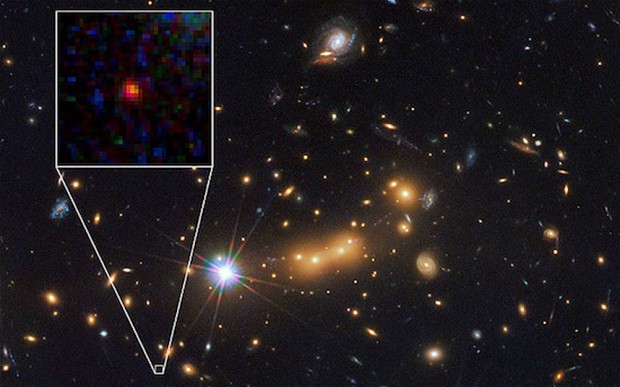Segundo a teoria do BIG BANG o Universo foi criado há 15-20 mil milhões de anos. O Telescópio Espacial Hubble (HST) já descobriu galáxias a cerca de 15 mil milhões de anos-luz de distância. Isto quer dizer que a emissão dessas galáxias foi feita há 15 mil milhões de anos atrás e muitas delas podem até já não existir ou então terem mudado de lugar ou de forma. Se construirmos um telescópio ainda mais potente que o HST será que não poderíamos ver esta explosão?
Nos últimos anos avançamos muito no nosso conhecimento acerca do Universo. No presente temos a idade do Universo estimada em 13.7 mil milhões de anos. A galáxia mais distante
fotografada pelo HST situa-se a cerca de 13.3 mil milhões de anos-luz. Esta galáxia, designada por MACS0647-JD, formou-se quando o Universo tinha apenas cerca de 400 milhões de anos (ver Fig. 1).

A Galáxia Fig. 1 - MACS0647-JD a
13.3 mil milhões de anos luz / Galaxy MACS 0647-JD, 13.3 billion light years away (NASA)
Tem razão quando diz que estas galáxias tão distantes podem já não existir ou então podem ter mudado de posição ou de forma. As galáxias normalmente surgem agrupadas em enxames e estes por sua vez
juntam-se para formar super enxames de galáxias. No centro dos super enxames de
galáxias existem galáxias elípticas gigantes resultantes da fusão de galáxias
mais pequenas. A nossa própria galáxia, por exemplo, está a "devorar" uma
pequena galáxia chamada Galáxia Anã do Sagitário. Para além disso estamos em
rota de colisão com a galáxia de Andromeda!
O Universo está em expansão. Nos primeiros segundos após o Big Bang o Universo
era extremamente quente. Com o passar do tempo o Universo vai arrefecendo em resultado da sua expansão.
Isto possibilita que se vão formando estruturas cada vez mais complexas. Quando a idade do Universo era de aproximadamente 0.00001s os quarks juntaram-se para formar protões e neutrões (antes era impossível isso acontecer).
Aos 3 minutos o Universo já era suficientemente frio para permitir a formação dos núcleos atómicos mais simples
(os protões e neutrões juntaram-se para formar núcleos atómicos de deutério, hélio, lítio e berílio).
Foi necessário esperar até aos 380 000 anos para que fosse possível que os electrões se juntassem a esses núcleos atómicos formando átomos neutros. Quando isto aconteceu os fotões (partículas de luz) ficaram finalmente livres
(antes os fotões chocavam constantemente com os electrões e não podiam percorrer grandes distâncias sem serem desviados).
Dizemos que aos 380 000 anos de idade o Universo tornou-se transparente para os fotões. Muitos dos fotões que se tornaram livres nesta fase continuam a cruzar o Universo.
Atualmente podem ser detectados como uma radiação cósmica de fundo na banda das micro-ondas. Não é necessário construir de momento um telescópio mais potente do que o HST.
Está neste momento operacional no espaço o telescópio espacial Planck que sucede ao WMAP (com estas missões e outras estamos a obter resultados com uma precisão sem precedentes) - ver Fig. 2.

Fig. 2 - Imagem da radiação cósmica de fundo obtida pelo
Planck / Cosmic Microwave Background, as seen by Planck (ESA).
According to the BIG BANG theory, the Universe was created 15-20 billion years ago. The Hubble Space Telescope (HST) has already discovered galaxies about 15 billion light-years away. This means that the emission of these galaxies was made 15 billion years ago and many of them may even no longer exist or have changed place or shape. If we build a telescope even more powerful than the HST, could we not see the Big Bang?
In the last few years, there has been great profess on our knowledge of the Universe. Currently, we estimate the Universe's age to be around 13.7 billion years. The most distant galaxy, photographed by the HST, is about 13.3 billion light years away. This galaxy, designated by MACS 0647-JD, was formed when the Universe was only about 400 million years old (see Fig. 1).
You are right when you say that these galaxies so far away may no longer exist or may have changed their position and/or shape. Galaxies usually appear grouped together in clusters and these in turn come together to form super clusters of galaxies. At the center of superclusters of galaxies are giant elliptical galaxies resulting from the merger of smaller galaxies. Our own galaxy, for example, is "devouring" a small galaxy called the Sagittarius Dwarf Galaxy. Furthermore, we are on a collision course with the Andromeda galaxy!
The Universe is expanding. In the first few seconds after the Big Bang, the Universe was extremely hot. Over time, the universe cooled because of its expansion. This allows for the formation of increasingly complex structures. When the age of the Universe was approximately 0.000 01 s, quarks came together to form protons and neutrons, which was previously impossible. At 3 minutes, the Universe was already cold enough to allow the formation of the simplest atomic nuclei (protons and neutrons came together to form atomic nuclei of deuterium, helium, lithium and beryllium). It was required to wait until 380 000 years for the electrons to join these atomic nuclei to form neutral atoms. When this happened, photons, particles of light, were finally free, since before, photons constantly collided with electrons and could not travel long distances without being deflected.
We say that, at 380 000 years old, the Universe became transparent to photons. Many of the photons that became free in this phase continue crossing the Universe. Currently, they can be detected as a cosmic background radiation in the microwave band. It's not necessary to build a telescope more powerful than the HST now. The Planck space telescope, which succeeds the WMAP, is currently operational in space, and with these missions and others, we are obtaining results with unprecedented precision - see Fig. 2.

